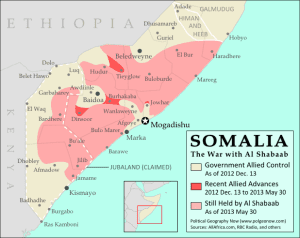This past week, terrorists struck Westgate Mall in Nairobi. Al Shabaab, a Somali Islamist organization, claimed responsibility. Frustratingly, we still know very little about the attackers, their origins, or the Kenyan security forces’ response. And the news about the last just keeps getting worse.
But there has been some analysis of the attacks – by both journalists and academics. In one of the most widely-circulated pieces, Somalia specialist Ken Menkhaus suggested that the attacks were a sign of desperation, the last gasp of an organization that had run out of an intra-Somalia game (also, here and here). Another strand of argument suggests that the growing ascendancy of a single Al Shabaab leader, Abdul Abdi Godane, has pushed the organization toward Al Qaeda, toward international jihad, toward further attacks on soft targets abroad (here and here and here). The presumption is, again, that we’re at a critical juncture for Al Shabaab, a moment of inflection at which the organization changes its character and its aims. See my AU colleague Joe Young’s piece at Political Violence @ a Glance for a roundup of some of this.
In this post, I’m going to make some empirical quibbley points about Somalia, and then I’m going to make a couple of substantive points about terrorism / COIN analysis in general. So if you’re not terribly interested in Somalia, you still might want to skip to the end.

Both of the Shabaab narratives above are based on magnification. Al Shabaab has suffered serious setbacks over the past year (which continue), and it is in the midst of an often-violent centralization of power under Godane. But it is not a militarily defeated organization. ANISOM’s position is very fragile, local and clan politics remain fluid (especially in volatile Juba), and Al Shabaab itself still has access to resources and the power to recruit. If we think over the last ten years in Somalia (the Ethiopian invasion period is particularly instructive here), it doesn’t seem a reach to imagine Al Shabaab reconstituting itself as a successful military force – perhaps under a different name, perhaps with less “global jihad” content. Even if it doesn’t, it could easily remain an obstacle to the Somali government establishing effective control over the significant amount of territory beyond its current Kismayo and Mogadishu islands. Regarding Islamism and global jihad, there have always been two faces of Shabaab, and this is likely to continue. I’ll say more on this below. But let me also point readers to an excellent April piece by Stig Hansen that makes this point. Hansen is the author of the recommended Al Shabaab in Somalia (OUP, 2013).
So, yes, Al Shabaab is diminished in terms of its control within Somalia, but the future remains uncertain. Focusing on military gains by ANISOM and KDF troops (now also ANISOM) is precisely the wrong way to think about the coming years. For the right way, go and read Armin Rosen’s Foreign Policy piece immediately.
So that’s the end of my Somalia points. On to tentative points about the broader discussion of Somalia and Westgate … and Mali and Boko Haram and so on.
- The O’Bagy / McCain problem. I worry about the rush to confirm commentary that agrees with what we would like to believe. This is a particularly a problem for contexts where there is low baseline knowledge (i.e., all of Africa). I certainly saw this with the Menkaus piece, which many other regional specialists would have quickly dismissed as far too sunny a picture.* Bias in one direction or another wouldn’t be a terrible thing, if the US government invested in in-house expertise or used a broad swathe of regional experts to inform policy. But, at least from where I sit, regional expertise (especially Africa expertise) is largely silo-ed off from the policy world in the US, meaning that there are, at best, too few informed voices and, at worst, a reliance on COIN specialists who simply cannot know well all the countries on which they are expected to comment. The UK is vastly better at both building expertise within the foreign service and seriously engaging with (and funding) scholarship. I’m not sure this is getting worse in the States, but it feels like it’s getting worse.
- Terrorism as strongly transnationally-linked, as Al Qaeda-influenced. With Al Shabaab and most other violent Islamist organizations in Africa, there’s also been a rush to view all terrorist attacks on the continent through the lens of Al Qaeda and international signaling. Thus, the very real (and overwhelmingly domestic) uptick in Al Shabaab’s use of terrorist attacks is viewed as a sign of increasing integration with Al Qaeda, as an attempt to curry favor with Al Qaeda, as a move that naturally alienates Shabaab from its base. None of that is necessarily true. Indeed, as Hanson suggests, Shabaab has played local and international games simultaneously since its inception. But Shabaab does have strong connections with Al Qaeda and global Islamism. In other cases, connections are much weaker and local dynamics much more important. For instance, journalists have often insinuated a strong international component to Boko Haram terrorism in Nigeria, despite little evidence that this exists. During the operation in Mali, there were suggestions of cooperation between Mali’s Islamists and Boko Haram — with no evidence that this was the case. Even in the past couple of days, I’ve heard two political scientists suggest that Boko Haram attacks in Yobe were a form of outbidding in response to Westgate.
The growth in terrorism and Islamism across north Africa and the Sahel is real. But the organizations behind these trends are often quite canny in leveraging local grievances and pre-existing social institutions unrelated to Wahhabi Islam. More importantly, I’m skeptical that we can link tactics and appeals to particular configurations of organizational resources or particular moments in organizational lifecycles. Increased collaboration with Al Qaeda, increased deployment of the language associated with international Islamist organizations, increased attacks on soft targets or international actors: these things can convey weakness. For instance, they might suggest a greater need to recruit from abroad, build local prestige via high-visibility attacks, or attrack money from Al Qaeda sympathists in the Gulf. But they can easily coexist with strong organization, with less religiously- or internationally-centered local recruitment, with adaptable leadership capable of playing a sustained, long-term, two-level game.
It makes sense that American-based analysts would tend to overestimate both the importance of international audiences and the extent of international collaboration … but these distortions shape policy. And they lead to what is quickly become a single approach to counterterrorism: increased US and Israeli training and support of local militaries — with some not-great consequences.
* I should be clear: I’m not complaining about Menkhaus, an excellent scholar who has often emphasized the shadowier sides of developments in Somalia.


This is a great post. Clionadh Raleigh has written a similar piece about the totalizing, universalizing Western discussion of terrorism in Africa that fails to recognize the local grievances at play in different contexts. That piece with Caitriona Dowd is in African Affairs and called “The myth of global Islamic terrorism and local conflict in Mali and the Sahel”
With respect to Somalia, Clionadh’s dataset on armed conflict ACLED shows violence to be increasing in Somalia, even as al Shabaab is supposed to be weakened after the 2011 famine. Perhaps the tide has turned in ways that aren’t evident from the data, but it seems like there is some wishful thinking that al Shabaab was defeated, but it seems more like a retrenchment and strategic pause before further escalation of violence. I’m not deeply immersed in the logistics on the ground, but as someone who is looking at the data and following the news on Somalia more closely than I once was, it doesn’t look like a group that’s necessarily on its way down.
Re ACLED, I think what it might pick up is deaths reported in foreign media? There are two reasons that deaths might be picking up. As linked above, we’ve seen a strong increase in Al Shabaab terrorist attacks on soft targets within Somalia, many of which resulted in large number of fatalities. Second, there are continuing military operations that yield casualties but few territorial gains. Kismayo, for instance, gets regularly shelled by Shabaab sitting just outside. ANISOM also continues to take losses. Indeed, families and others have been disputing the official battle death reports, saying casualties are higher than reported.
Thanks for the Raleigh and Dowd citation. I haven’t seen it. I’m trying to avoid this area, but, as a Kenya and Nigeria specialist, it seems inevitable that I’ll be drawn into it. A friend has also recommended a CUP book by sociologist Lisa Stampnitzky, Disciplining Terror: How Experts Invented Terrorism. If the flattening tendency of terrorism studies comes its origins and its interrelationship with policy makers (as I suspect it may), then Stampnitzky’s book would likely be useful.